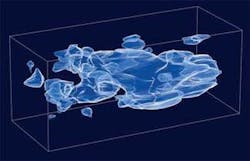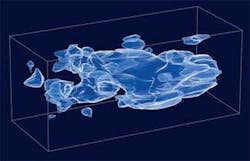Hubble and ground-based telescopes map dark matter
An international team of astronomers using NASA’s Hubble Space Telescope has created the first three-dimensional map of the large-scale distribution of dark matter. The new map provides the best evidence to date that normal matter, largely in the form of galaxies, accumulates along the densest concentrations of dark matter. The map reveals a loose network of filaments that grew over time and intersect in massive structures at the locations of clusters of galaxies. The dark-matter map was constructed by measuring the shapes of half a million faraway galaxies.
To reach Hubble, the light of galaxies traveled through intervening dark matter that deflected the light slightly as it traveled through space. Researchers used the observed, subtle distortion of the galaxies’ shapes to reconstruct the distribution of intervening mass along Hubble’s line of sight, a method called “weak gravitational lensing.” To add 3-D distance information, the Hubble observations were combined with multicolor data from powerful ground-based telescopes-Europe’s Very Large Telescope in Chile, Japan’s Subaru telescope in Hawaii, and the U.S.’s Very Large Array radio telescope in New Mexico-as well as the European Space Agency’s orbiting XMM-Newton X-ray telescope. Contact Richard Massey at [email protected].

